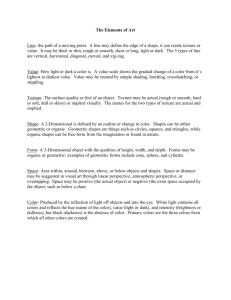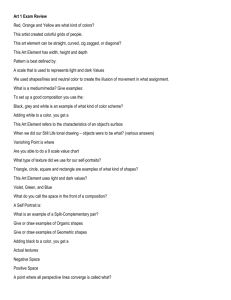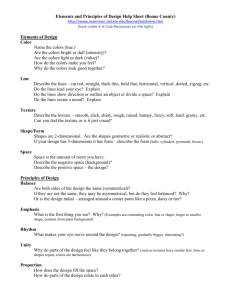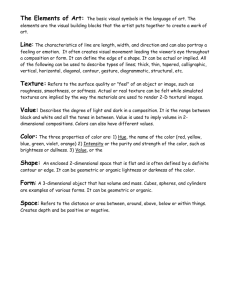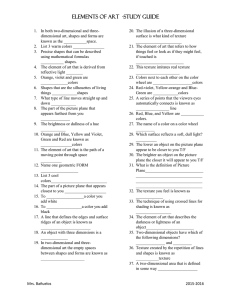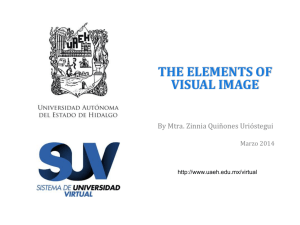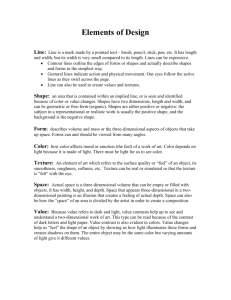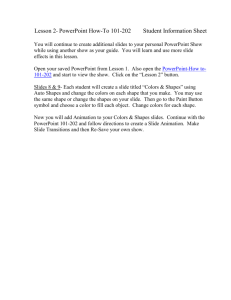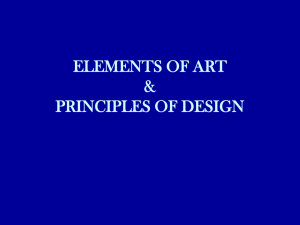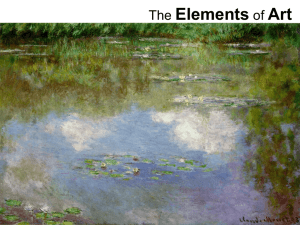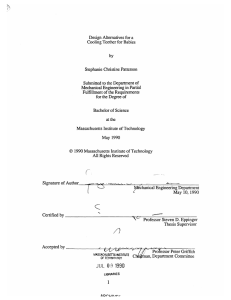Elements of Art
advertisement
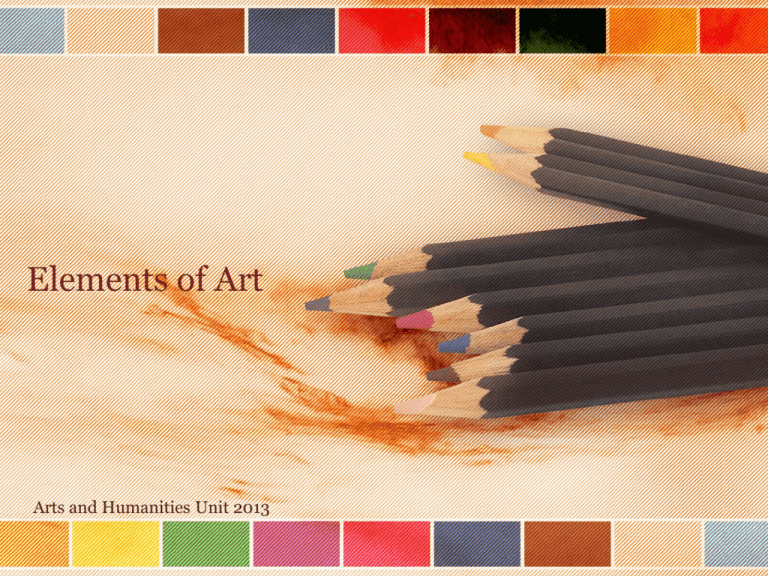
Elements of Art Arts and Humanities Unit 2013 TUESDAY Elements of Art • The elements of art are the basic components (tools) that artist use to visually communicate. 7 Elements of Art • Line • Shape • Form • Value • Texture • Space • Color Line • A mark drawn with a pointed, moving tool. Picture by Peit Mondrian Main Types of Lines • Horizontal • Vertical • Diagonal • Straight • Curved Contour Lines • Lines that define the form of an object Implied Lines • Line that is not really painted or drawn but is created by a value or color change and series that are lined up someway. Gesture Lines • A gesture is an expressive movement. • The purpose of drawing gestures is to capture the feeling of motion. WEDNESDAY Shape • A two-dimensional area that is defined in some way with no form or thickness. • Shapes are flat and can be grouped into two categories: Geometric and Organic. Geometric Shapes Organic Shapes Geometric Shapes • Geometric Shapes are precise shapes that can be described using mathematical formulas Organic and Amorphous Shapes • Irregular or uneven shapes Question #4 by Joan Miro Green Tea Cup by Janet Fish • Question #5 THURSDAY Form • A three dimensional enclosed object • Form can refer to an actual three-dimensional object, like a sculpture or a building. It can also refer to a photo or picture of the threedimensional object. The White House Statue of Liberty Form can be organic or geometric Question #3 Two-Piece Reclining Figures by Henri Moore Question #4 The Great Pyramids in Giza Egypt Week 2 Elements of Art- A&H Unit 2013 MONDAY Value • The degree of light and dark in a design Value Scale Shading • Also known as blending is a way of creating value and making objects look more threedimensional. Value is the same thing as shading and can make drawings look more realistic and threedimensional Hatching and Cross Hatching • Techniques used to create values with parallel lines Stippling • Technique that uses dots to create values TUESDAY Texture • Texture refers to the way things feel or look like they would feel. Actual or “Real” Texture • Refers to the textures that you can really feel. Basket The Awakening by J. Seward Johnson Located at Hains Point outside of Washington DC Implied Textures • Refers to textures that are created on a flat surface in paintings or drawings. This type of texture cannot be felt. Still Life By Janet Fish Rubbing • A technique for transferring texture to paper WEDNESDAY Space • In painting and drawing, space is the illusion of depth created by an artist on a flat surface Parts of Space Negative Positive • Positive Space – The objects in the art work. • Negative Space – The empty space between and behind the shapes American Gothic by Grant Wood Different types of Space in Art • Infinite or Deep Space – Lot of Area Marriage of the Virgin by Raphael Different types of Space in Art • Shallow Space – Little or no area Sunflower by Vincent van Gogh Perspective • Linear Perspective is a way of using converging lines to show distance and depth Atmospheric and Aerial Perspective • Uses the atmospheric haze created by humidity, snow, smoke, rain, or other types of vapor to create the illusion of depth. THURSDAY Color • The element of art that is derived from reflected art. • Primary Colors- The colors you must have to mix all other colors plus black and white. Red Blue Yellow Secondary Colors • Colors made by mixing two primary colors together. Purple or Violet Orange Green Color Wheel Neutral Colors • Black, Brown, Gray, and White Warm Colors Cool Colors TintTo add white To a color ShadeTo add black To a color Monochromatic • Variations of one color
